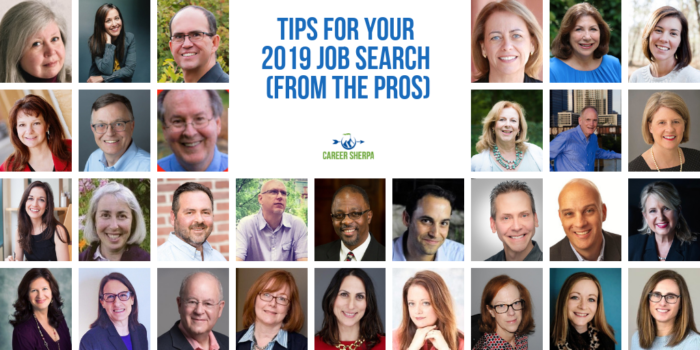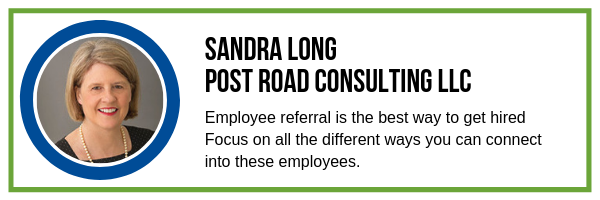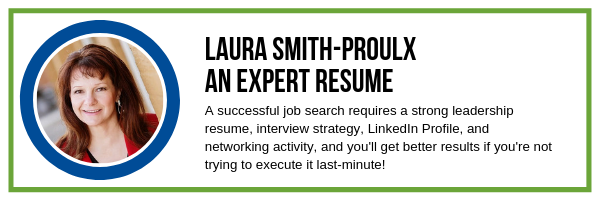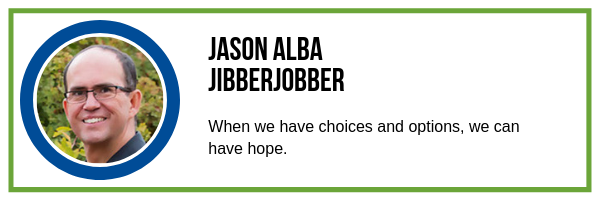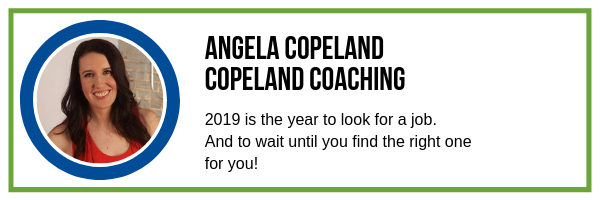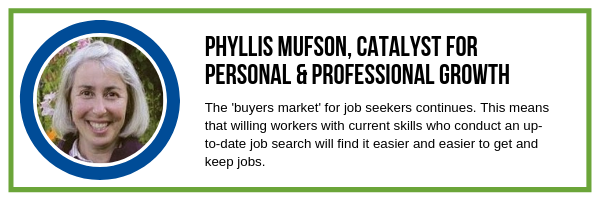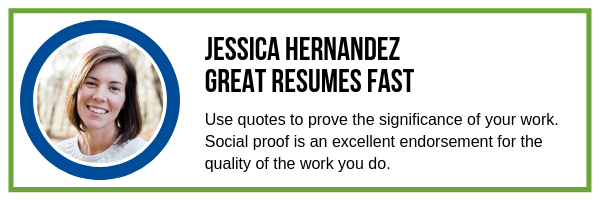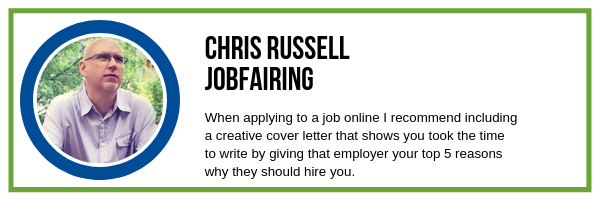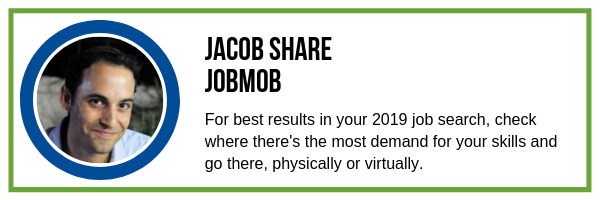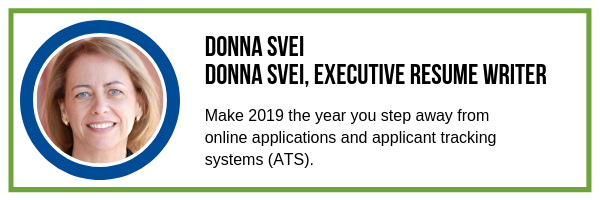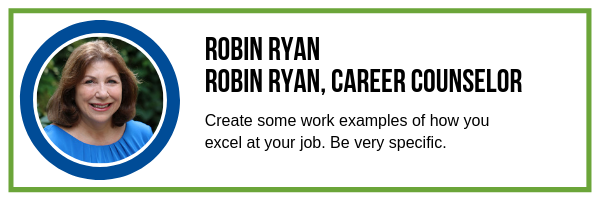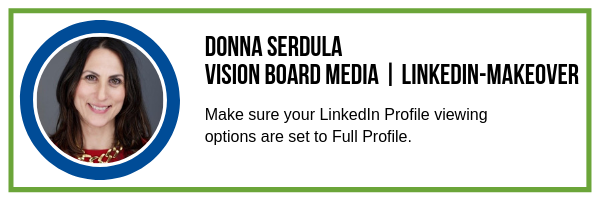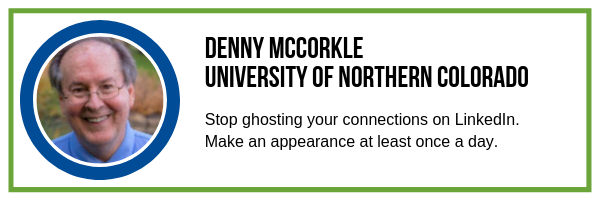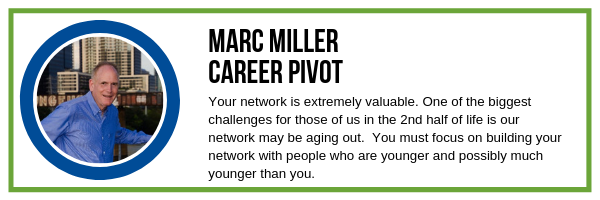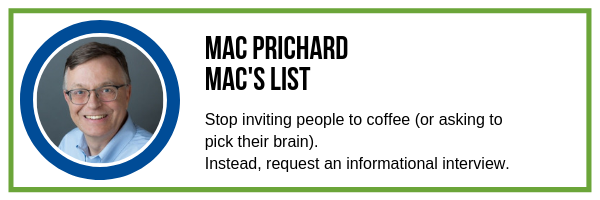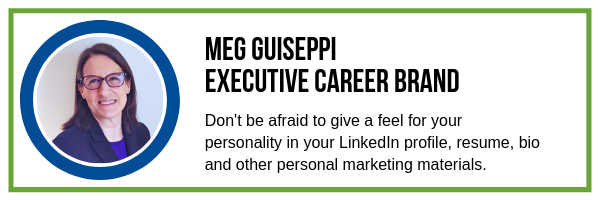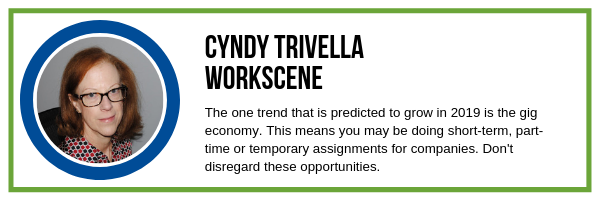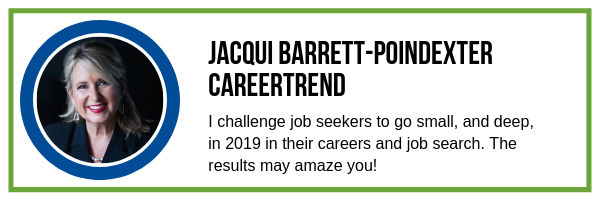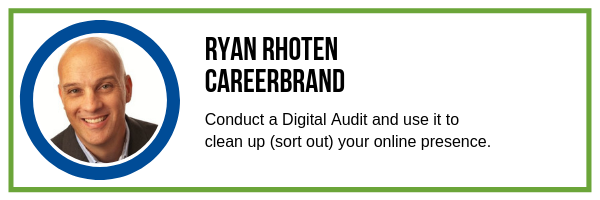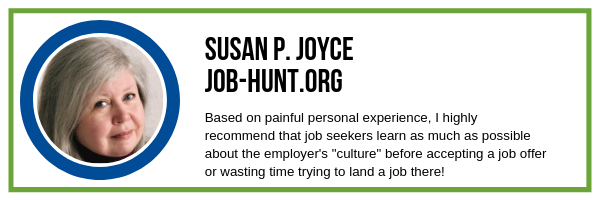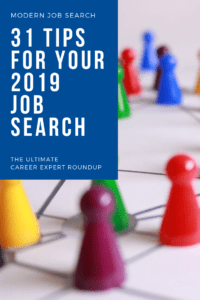If you plan on looking for a new job this year, then you’ll want to pay attention to these 31 tips for a 2019 job search from career experts! They’ll help you launch and execute an effective 2019 job search.
You don’t have time to learn how to job search by trial and error.
That’s why I tapped these career professionals and asked for their top job search tips (and favorite resources).
They live and breathe job search. Every day they are coaching job seekers, writing LinkedIn profiles and teaching interview strategies. These folks have seen and heard it all. That’s why their advice is so valuable.
As you read through these tips and see their favorite resources, I hope you will gain a new perspective on what it takes to land a new job.
There’s no true shortcut to securing a new job, but you won’t find a better source of information and job search strategies for 2019.
Note: Always make the extra effort. Whether it’s tailoring your resume for a job or sending a thank you message after an interview…the extra work you invest shows your interest and professionalism. Most importantly, it helps you stand out.
TARGETING
Lisa Rangel | ChameleonResumes.com
Don’t depend on job boards.
Do the activities that will help you uncover the unpublished job openings where fewer applicants apply. Reach out to hiring managers directly with a powerful resume that will inspire them to create a great position around your skills.
Favorite resource: Chameleon Resumes’ Resume Tip Sheet
Adrienne Tom | Career Impressions
Identify your ideal job target before commencing a search.
If you don’t know what your ideal job looks like you won’t know how to find it or execute a clear strategy with well-aligned tools (resume, LinkedIn profile, etc.).
Start by identifying the job title and work requirements that interest you.
Consider the type of work environment you perform best in (team-based, independent, or a combination of both). Ponder preferred company size, industry, culture, location, and structure. Now create a target list of companies that align with these requirements and start researching opportunities.
If opportunities don’t yet exist, strategize on how to create them. Leverage your network and the power of internal referrals to support your search execution. Let people know who you are, the value you have to offer, and exactly what you are looking for. Aim to make contact with decision-makers.
Finally, develop strong, relevant career tools that speak to, and address, the pain points of your ideal job and unique audience.
These combined efforts will prevent you from spinning your wheels and relying on an outdated ‘spray and pray’ job search approach. Targeted efforts are what will increase job search success in 2019.
Sandra Long | Post Road Consulting LLC
Employee referral is the best way to get hired.
Focus on all the different ways you can connect into these employees. For example, find alumni from your school who work at your target employers by using LinkedIn search. Reach out to them to ask for insights about the company. Your conversation may result in a referral to the hiring manager.
Favorite resource: The LinkedIn Page for YOUR university. Click on Alumni tab and use the filters to find alumni based on employer, geography, industry, and function.
Virginia Franco | Virginia Franco Resumes
Create lists.
Create a list of companies that interest you and people you know.
Tip: LinkedIn can help you create both and see where the items on your list intersect!
Laura Smith-Proulx | An Expert Resume
Plan ahead.
A successful job search requires a strong leadership resume, interview strategy, LinkedIn Profile, and networking activity, and you’ll get better results if you’re not trying to execute it last-minute! Assess your competitive strengths, document career wins, and build a potent social media profile, then strategically reach out to desirable contacts using job clubs, direct employer contact, and regular LinkedIn activity for greater visibility. Use the tips provided through Job-Hunt.org if you’re unsure where to start.
Favorite Resource: Job-Hunt.org
MINDSET
Jason Alba | JibberJobber
Hope comes from choices.
I’ve learned that one of the most important things to have in your job search is hope. I’ve met with countless job seekers over the last 12+ years and while many put on a good face, once we talk a bit it isn’t too hard to learn that many people have lost hope… that they’ll land a job, that they’ll be happy in a job they land, that getting a job is “the answer,” etc.
Without even talking about discrimination or new-fangled ways of getting a job today, the big question is “will what I do matter? Will it be meaningful?” Add that to “how long will my next job last” and you have a lot of people who are not as hopeful as they once were.
I learned from the late Dick Bolles that hope comes from choices. When we have choices and options, we can have hope.
My hope came through entrepreneurship, yours might come from a change in industry or profession, or a new financial situation (downsizing, so you don’t need to make more at a job you hate but can make less at a job you love), etc.
I recently got laid off from The Best Job In The World, but during the layoff all I could think about was my other income streams. I had other options, and I had plenty of hope. It is my desire that you can find hope for yourself and your career in 2019 through choices and options!
Favorite Resource: JibberJobber.com (JibberJobber is an online app to help you organize and track your job search and relationships. It is a great tool during the job search, and the right tool for career management.)
Angela Copeland | Copeland Coaching
2019 is the year to look for a job.
And to wait until you find the right one for you! It’s the best job market that we’ve seen in an entire generation. Start looking, but don’t take the first thing that’s offered to you. It’s a job seeker’s market!
Favorite Resource: I really love the Workforce Report that LinkedIn shares each month. They identify gaps in skills, and often highlight areas of the country where certain skills are lacking. This is a great report to reference if you’re open to changing your geographic location. Here’s the latest report.
STRATEGY
Phyllis Mufson | Catalyst for Personal & Professional Growth
The ‘buyers market’ for job seekers continues.
In 2018 there were many more job openings in the US than workers to fill the jobs, making it a ‘buyers market.’ This welcome news for job seekers will continue into 2019 and possibly for decades, due to big demographic changes. The Baby Boomer generation is filtering out of the workforce and the birth rate has reached a 30-year low. The birth-rate is now below the level needed to replace current retirees.
This means that willing workers with current skills who conduct an up-to-date job search will find it easier and easier to get and keep jobs.
Jessica Hernandez | Great Resumes Fast
Use quotes to prove the significance of your work.
Social proof is an excellent endorsement for the quality of the work you do. Ask for short quotes or testimonials from your network, former bosses, or take an excerpt from one of your LinkedIn profile recommendations.
Avoid ambiguous testimonials like “John is a great guy. We really value the work he did for us.” Instead, select a recommendation that’s specific: “John always takes the time and goes the extra mile for his clients. Because of his exceptional client care, he secured a $2M contract with a previously competitor-aligned company.”
Using a short quote is a great way to boast about yourself without coming off arrogant or prideful. Which is wonderful for those who are uncomfortable boasting about their wins. It also provides the much-needed proof and validation that employers are so hungry for.
Chris Russell | Jobfairing
Put some creativity in your application.
When applying to a job online I recommend including a creative cover letter that shows you took the time to write by giving that employer your top 5 reasons why they should hire you. I actually create a graphical image that includes the company logo and an avatar of myself in order to stand out.
Jenny Foss | JobJenny
Don’t try to talk to everyone.
You’ll dilute the strength of your message across every single channel. Instead, narrow your target audience as much as you can. This tends to really scare people. They fear that they’ll miss out on an opportunity if they don’t leave all avenues open. But the problem with trying to target too many jobs or industries at once is that you make your efforts nearly impossible.
Dorothy Dalton | 3Plus International
Stay in touch…
My campaign for 2019 is to encourage women to stay in touch with the job market on an ongoing basis, which they tend to do less than their male colleagues. This puts them at a competitive disadvantage which makes them reactive rather than proactive and then more vulnerable in crisis situations.
Favorite Resource: 3Plus International’s Job Search Planning Template
Jacob Share | JobMob
Know what (and where) there’s demand.
For best results in your 2019 job search, check where there’s the most demand for your skills and go there, physically or virtually. High demand jobs lead to companies who are desperate to hire and willing to do more to get you on board.
In some industries and geographic locations, demand is so high, companies will even train you in the few skills you don’t have as long as you have others they need. For example, the blockchain industry has been exploding the past few years, and while most of the jobs created are for tech people, there are many related jobs that are needed to fill out those growing companies.
Favorite resource: How To Get Into Blockchain Case Studies
Donna Svei, Executive Resume Writer
Make 2019 the year you step away from online applications and applicant tracking systems (ATS).
Recent research by Lever, a recruiter marketing firm, found that you have a 1:152 chance of getting a job when you apply through an ATS. By comparison, you have a 1:16 chance of getting a job when someone refers you to your target company. Make 2019 the year you make the effort to get referred to jobs!
Favorite Resource: Use This 10X Job Search Strategy
JOB INTERVIEWS
Sarah Johnston | Briefcase Coach
If you have interviews coming up, it’s always a good idea to practice.
It’s impossible to perfectly predict what you’ll be asked, but you can anticipate themes (like: teamwork, organization, stress, diversity, difficult person, customer service, etc.) and prepare example stories that you can adapt depending on the wording of the question. It’s also a good idea to practice questions like “Tell me about yourself” or “greatest strengths/weakness” that have a high probability of being asked. Time spent practicing for an interview is never wasted time. You may only get one chance to interview for a dream opportunity.
Favorite Resource: Hunter.io is one of my favorite websites for research. If you find a decision maker on Linkedin and you are unable to find their e-mail address, Hunter is a great place to start. The site can also verify e-mail addresses.
Sharlyn Lauby | HR Bartender
Prepare for the job interview.
While this has always been important, I’m amazed at the number of recruiters that tell me how unprepared candidates are for the interview. (i.e. don’t know what the company does, have no questions prepared, etc.)
Favorite Resource: 12 Things that Recruiters are Looking For Right Now
Alex Freund | The Landing Expert
Win by understanding the thought process.
The job interview is a competition in the marketplace. You can’t win unless you understand the thought process of the interviewer/decision maker. (see the 4 principles below).
Favorite Resource: The Four Principles of Acing an Interview
Robin Ryan, Career Counselor | RobinRyan
Do this before your job interview.
Create some work examples of how you excel at your job. Be very specific. Outline where you were working, the skills you were using i.e. project management or leadership ability, state what you did and note the outcome or results of your efforts. These examples answer the situational questions many employers ask, but they can also answer some general questions and make it clearer to the employer how effective you are at performing the job. Write these work examples answers out and rehearse them. Then try them out on a friend. Get feedback. Perfect the answer before your interview.
Jared J. WIESE | Profiles That POP!™
Have a strong LinkedIn profile.
I’ve heard repeatedly from clients that about 6 years ago the job search changed. You could no longer post a résumé to job boards or even count on your old network. With over 87% of recruiters on LinkedIn, having a strong LinkedIn profile is critical.
Favorite Resource: The Best Free Advice to Get a Job
Donna Serdula | Vision Board Media, LinkedIn-Makeover
Make sure your LinkedIn Profile viewing options are set to Full Profile.
This means, when you visit a person’s profile, your name and a link back to your profile will be recorded on their “Who’s Viewed Your Profile” stats page.
Why is this so important?
Let’s say you are asked to interview for a position. Prior to the interview, you check out the person’s profile who is conducting the interview. You want to know who this person is and you want to see what you may have in common. If you are set to Full Profile, the interviewer can see you checked out their profile. Don’t get nervous… THIS IS A GOOD THING! The interviewer now knows you are interested in the position and in them. They also know you are technologically savvy and that you are smart enough to do your due diligence and research. These are really important things.
Something so simple can really set you apart from other candidates who interviewed for the same position.
That little view can also act as a breadcrumb trail back to your LinkedIn profile… and if you optimized your LinkedIn profile, the information on your profile can act as an enforcer of why you are the ideal candidate for the position.
Denny McCorkle | University of Northern Colorado
Stop ghosting your connections on LinkedIn. Make an appearance at least once a day.
Social sharing career-related content shows potential employers and career stakeholders what you are LEARNING. Adding career-relevant comment to the social shares of others shows them what you are THINKING. And, social sharing your own accomplishments and professional activities shows them what you are DOING.
Favorite Resource: Flipboard is an excellent app to follow career-related news and career topics of your choosing. And, it provides you a real-time resource of content to social share on LinkedIn and other social media.
NETWORKING
Marc Miller | Career Pivot
Older job seekers need a network of younger workers.
One of the biggest challenges for those of us in the 2nd half of life is our network may be aging out. The people who helped us along may have retired, be no longer be in a position of influence or they may have died.
You must focus on building your network with people who are younger and possibly much younger than you. Even network with young people who are not in a position of power today but may be tomorrow. You never know who might be able to help you in the future.
Favorite Resource: Has Your Network Aged Out and Abandoned You?
Mac Prichard | Mac’s List
Stop inviting people to coffee (or asking to pick their brain).
Instead, request an informational interview.
Would you ask your boss, a leader in your field, or a coworker to a business meeting without an agenda, a time limit, and an outcome in mind?
Of course you wouldn’t. In an informational interview, you have goals for the conversation. You also know the results you want. And you consider the other person’s needs and how to meet them.
When you take these steps, you will get so much more from the conversation. And you will grow a relationship that will likely last long after your search ends.
When requesting an informational interview, it’s up to you to make the best use of everybody’s time and help persuade others to say yes to your request.
Favorite Resource: Stop Buying People Coffee (or Asking to Pick Their Brain)
PERSONAL BRANDING
Meg Guiseppi | Executive Career Brand
Be an original.
An important strategy for 2019 that’s been with us for years, but too many have still not embraced: Don’t be afraid to give a feel for your personality in your LinkedIn profile, resume, bio and other personal marketing materials.
Your job search profiles and documents are meant to differentiate the unique value you offer the employers you’re targeting, over the possible sea of other people competing against you. You’re much more likely to become a candidate of interest if you lean on your personal brand in these supporting materials.
We all know that recruiters and hiring decision makers sourcing talent look for candidates who have the right “hard skills”. More than ever, in 2019, they’ll also be looking for the right personal qualities or “soft skills”. Before reaching out to you, they want to get some idea of how you make things happen, how you work with people, what kind of leader or manager you are. This helps them see whether you’ll fit the company’s culture.
Don’t go overboard, but don’t be afraid to say things about yourself that you’ve never seen in a LinkedIn profile or resume. Things that indicate who you are . . . the way you operate and contribute . . . your guiding principles . . . your unique defining motto.
You’re an original. You’re not the same as your competitors. Tell your singular story. Let your personal brand help you tell people what makes you different, better, and more valuable to them.
Favorite Resource: 23 Ways You Sabotage Your Job Search
TECHNOLOGY
Bob McIntosh | MassHire Lowell Career Center, ThingsCareerRelated
Learn mobile technology.
I lead workshops and counsel clients one-on-one at an urban career center, where the average age of our clients is 50 plus. Many of these job seekers haven’t had to look for work for 10, 20, 30 years, or more. The job search for them is an eye-opening experience, to say the least. One aspect of the search our clients struggle with is having to use their Smartphone to respond to hiring authorities.
Hiring authorities are increasingly using their smartphones to contact potential candidates, and they’re reaching out not only during work hours but beyond the sound of the whistle. As an older job seeker, you should be cognizant of the methods hiring authorities are using to find talent. If you haven’t had to look for work in many years, these are some of the tools you must get familiar with in order to compete in a competitive labor market. And as time progresses, the phone will become even more prevalent in the job search. Make sure you keep apace of hiring authorities, or you may be left in the dust.
Favorite Resource: Your phone should become your best friend. Here are some tools hiring authorities are using to fill positions:
- Texting. The days when we used to talk on the phone are becoming a distant memory. As an older job seeker, get used to hiring authorities texting you day and night.
- Dropbox, Google Drive, or iPhone Cloud. Store your résumé/s in these storage areas, so you can send them to employers when you’re away from your computer.
- Zoom, Skype, Facetime. Yes, these applications are not only for your laptop. Install them on your phone and practice using one or all of them with friends and relatives.
- LinkedIn’s mobile app. LinkedIn users are spending more than 50% of their time using the app. Some hiring authorities are using Messaging, as opposed to email, to communicate with potential candidates. Be sure to check your LinkedIn account daily, if not hourly.
- Twitter and Facebook. These two applications aren’t only for family fun and teen tweeting. Hiring authorities are searching for job seekers and expect you to be participants. Friend them on Facebook and follow them on Twitter. Demonstrate how tech savvy you are by using these applications.
Mark Anthony Dyson | The Voice of Job Seekers
Don’t compromise your data security and privacy at the expense of being “transparent and authentic”.
Take the extra steps to use discretion while trying to stand out. Review your Facebook privacy settings, and certainly, there are many resources to learn how to tweak it to your satisfaction.
Favorite Resource: Consumer Reports published their recommendations for extra security to protect your identification. It’s worth looking into here
TRENDS
Cyndy Trivella | WorkScene
Don’t overlook the gig economy.
2019 is estimated to be as much a job seeker’s market as 2018 was. This does give job seekers an edge in the job market now, but as we all know, the job market ebbs and flows, so never burn a bridge you may need to cross again in the future.
The one trend that is predicted to grow in 2019 is the gig economy. This means you may be doing short-term, part-time or temporary assignments for companies. Don’t disregard these opportunities; they are a learning experience. You will get a fine view of the organization from an insider’s perspective and gain a better understanding of the culture… not to mention, you now have direct contacts within the organization. Assess your financial solvency to determine if you can take on this work style and if so, consider it your foot in the door.
Favorite Resources: Each single information source is generally limited in what data is available, so don’t limit yourself to just one resource. It’s important to take into account all facets of a potential employer so using a variety of resources is recommended.
For example, resources like Yahoo Finance, the stock market (where applicable), The WSJ and Fortune can shed light on the financial health of an organization.
Social media (Twitter, Facebook, Instagram, Snapchat, etc.) can give you an indication of the company’s workplace atmosphere and often a view of the people who work there. Some industries, due to compliance and risk factors, choose not to have a presence on social media, so when looking for work, consider the industries of the companies you are targeting and not just the individual organizations.
Glassdoor and LinkedIn are a must use for anyone in a job search because you can find out who works at your target companies and on Glassdoor, what people are saying about these organizations. Caution: When using sources like Glassdoor, I recommend looking for trends or commonalities in comments rather than focusing on just the good or just the bad reviews. When using LinkedIn, try to find someone you can speak with who worked at the company you’re targeting. If the degrees of separation are outside of your ability to contact these individuals, look to see if you know someone who can make an introduction.
Another wonderful site is A Great Place to Work. Here you can find companies who have been ranked and rated by their own employees as an employer of choice and are the organizations who take the temperature of their culture often and seriously. Further, they have multiple categories for their coveted winners, so for example, you can easily search for companies in the retail sector if this is a targeted industry for you.
One resource that I highly recommend is setting up Google alerts on your target companies. Google alerts will keep you in the loop on the activity taking place at the companies on your target list. When appropriate, the information in the alerts can be integrated into your interview conversation and make you sound more knowledgeable about the organization, which is always a good thing.
And last but not least, use your people network. This will always be the most important resource you have.
SOCIAL MEDIA
Jacqui Barrett-Poindexter | CareerTrend
Go small + deep.
In today’s FOMO digital world, we easily get swept up trying to be everywhere all the time: LinkedIn, Instagram, Twitter, Facebook, etc. Whether promoting our career, upping our personal brand, building community, adding to our achievements trail, or a combination of all of those, it can be overwhelming + exhausting.
It also can create a mirage–the false impression you are gaining momentum through more and more exposure. While there is value in being digitally present, the value has diminishing returns when you try so hard to be visible and/or popular that your reputation for intimate, meaningful correspondence erodes.
I challenge job seekers to go small, and deep, in 2019 in their careers and job search. The results may amaze you!
Favorite Resource: Joe Jacobi’s “Sunday Morning Joe“
Marie Zimenoff | Career Thought Leaders
Your online activity will matter more in 2019 than ever before.
Job seekers have long known the importance of cleaning up their social media activity when in job search, but in 2019 social media activity will take on a new level of importance in job search and career advancement.
In 2018, a Jobvite survey of recruiters showed that 77% of recruiters are using LinkedIn to source and screen candidates, 63% are using Facebook, and 25% are using Instagram. In addition, companies are starting to use software that scans and scores social media profiles and activity to match candidates to openings.
The good news for job seekers is that in this tight labor market companies are using social media to proactively find candidates that might not fit the mold of a traditional applicant for the position. Engaging in conversations and communities around passions could put a job seeker on the radar for a position they would not have been deemed “qualified” for in years past. Being authentic and a bit more transparent could now be in their favor.
The bad news for job seekers is that the temptation to cross the line into vulgar, violent, and other negative conversations online is at an all-time high. While being passionate about a cause could create a connection point with a company, displaying rude behavior could get them ruled out for a position as software is also evolving to screen social media interactions for red-flag behaviors.
The bottom line? Job seekers who create profiles that connect with their audience and build their visibility through thought leadership and engagement in communities of interest will now have more opportunity to be found and stand out from the competition.
Ryan Rhoten | CareerBrand
Conduct a digital audit.
Conduct a Digital Audit and use it to clean up (sort out) your online presence.
Favorite Resource: CareerKred, Ryan Rhoten’s hot new book on how to audit, monitor and build online credibility!
CULTURE
Susan P. Joyce | Job-Hunt.org
Know the company’s culture.
Based on painful personal experience, I highly recommend that job seekers learn as much as possible about the employer’s “culture” before accepting a job offer or wasting time trying to land a job there! A relatively new website, Comparably.com (https://www.comparably.com), seems to do a much better job than other employer review sites of offering insight into company cultures.
Assuming that the “anonymous” employee reviews are genuine, Comparably looks like an excellent source of very important information about employers.
Employers are rated and receive “awards” in comparison with Comparably-determined competitors based on those employee reviews. The reward categories are very significant. Categories include: Company Culture, Best CEO, Diversity, Women (how women rate the work environment), “Happiness,” Compensation, Leadership, Managers, Perks and Benefits, Meetings, and Professional Development. This important information is broken down by department, job title, and location!
Favorite Resource: Comparably.com
Check out the presentation:

Hannah Morgan speaks and writes about job search and career strategies. She founded CareerSherpa.net to educate professionals on how to maneuver through today’s job search process. Hannah was nominated as a LinkedIn Top Voice in Job Search and Careers and is a regular contributor to US News & World Report. She has been quoted by media outlets, including Forbes, USA Today, Money Magazine, Huffington Post, as well as many other publications. She is also author of The Infographic Resume and co-author of Social Networking for Business Success.
